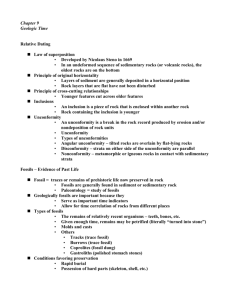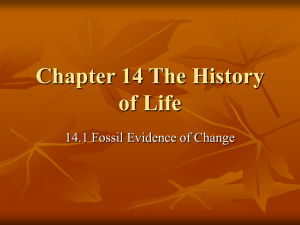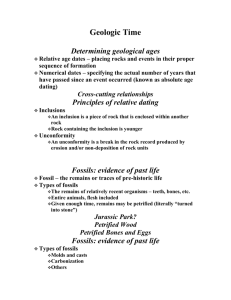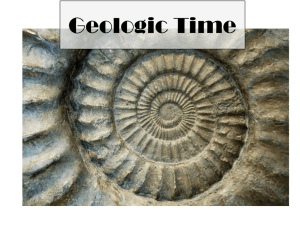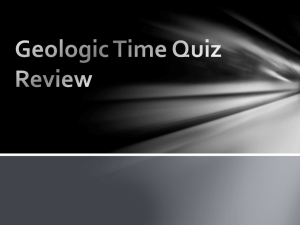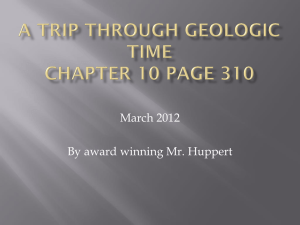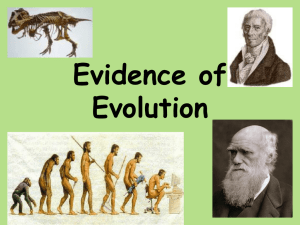Geologic History
advertisement
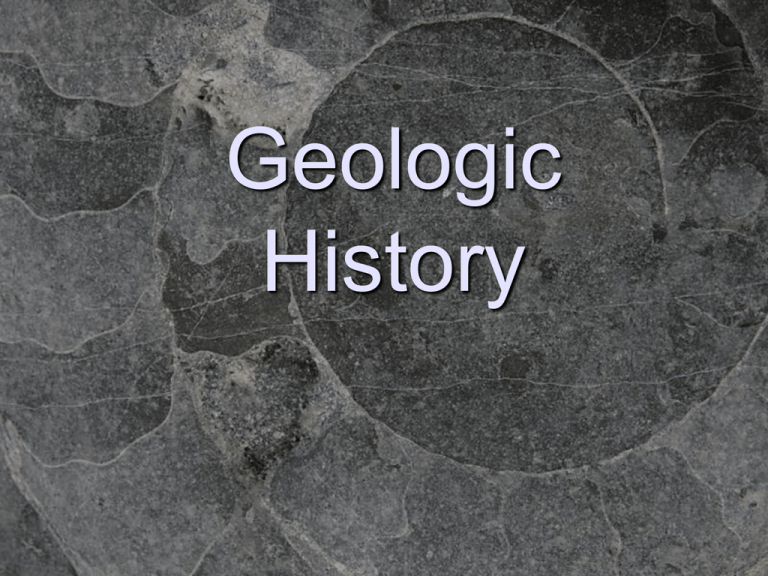
Geologic History Geologic Time Scale Geologic Time Scale Chart of Earth’s history showing events, time units, & ages Era: the four largest subdivisions of the geologic time scale – Precambrian, Paleozoic, Mesozoic, Cenozoic Period: subdivisions of eras on the geologic time scale Epoch: subdivisions of periods on the geologic time scale – ONLY in the Cenozoic Traces from our past • Index Fossils: a fossil of a species that existed briefly and was widespread geographically, used in determining the relative age of rock layers (i.e. trilobites) • Fossils and Ancient Environments: fossils can be used to determine what the environment of an area was like long ago. Traces from our past Fossils: the remains or traces of a onceliving organism preserved in rock. How fossils form: – organisms have a better chance of being preserved if they have hard parts (bones, shells, teeth, or wood) – usually found in sedimentary rocks Petrified Remains Petrified Remains – plant or animal remains that have been turned to rock; this happens when minerals carried in groundwater replace the original material. Petrified Wood Carbonaceous Film • Carbonaceous Film – a fossil impression in a rock, consisting only of a thin carbon deposit Mold and Cast Mold – a cavity in a rock that has the shape of a fossil that was trapped there; water dissolved the fossil away, leaving its imprint Mold and Cast Cast – type of fossil formed when an earlier fossil in rock is dissolved away, leaving behind the impression of that fossil, and new sediments or minerals enter the mold Original Remains • Original Remains – sometimes the actual organism or parts of organisms are found (mosquitoes in amber, wooly mammoth frozen in ice) Trace Fossil • Trace Fossil – footprints, worm holes, burrows & other traces of animal activity preserved in rock Trace Fossil Geologic Time Scale Age Dating Techniques Relative Dating: determining the order of events and the relative ages of rocks by examining the positions of rocks in layers Age Dating Techniques Relative Dating – another good diagram Uniformitarianism • In 1795, James Hutton described a ‘new concept’ stating that: – The geologic processes now at work were also active in the past. – The present physical features of Earth were formed by these same process, at work over very long periods of time • “the present is the key to the past” Relative Dating • Law of Original Horizontality: sediments are deposited in a horizontal fashion Relative Dating • Law of Superposition: in layers of undisturbed rock, the oldest are on the bottom, and rocks become younger toward the top Law of Superposition Relative dating • Law of CrossCutting Relationships: igneous rock intrusions or faults are younger than the rocks that have been intruded or faulted Relative Dating • Law of Included Fragments: pieces of one rock found in another rock must be older than the rock in which they are found Relative Dating • Correlation: the matching of rock layers from one area to another to establish a relative date Relative Dating Unconformity: one or more missing layers in a sequence of rocks, this is the result of gaps in the time/rock record • angular unconformity – tilted rock layers meet horizontal rock layers, this indicates layers are missing and there is a gap in the time record • disconformity – the top rock layer is eroded before the next layer can be deposited causing a gap in the time record Angular Unconformity Angular Unconformity Disconformity Disconformity Age Dating Techniques • Absolute Dating: determining the age of rocks using the radioactive decay of atoms. • Radiometric Dating: an Absolute Dating method that uses the rate of decay of radioactive isotopes in rocks. Age Dating Techniques • Radioactive Decay: the decay of an atom of one element to form another element, occurring when an alpha particle or beta particle is expelled from the original atom (Ex. parent atom (K) decays to daughter product (Ar)) • Half-Life: the time it takes for half of the parent atoms of an isotope in an object to decay into the daughter product (K-Ar = 1.3 billion years) Age Dating Techniques Tree rings – counting the number of rings on a cross section of a tree Radio-Carbon dating – the radioactive carbon isotope used for dating organic material: Carbon 14 decays to Carbon 12 The ‘half life’ of Carbon 14 is 5700 years… Half life – how long it takes for half of the material to decay Precambrian Time • • • • from 4.6bya to 545mya makes up ~90% of Earth’s history very little is known about fossils from this period cyanobacteria appeared around 3.5 bya – responsible for oxygen and indirectly for ozone in the atmosphere • invertebrates developed at end of era 545mya to 245mya Paleozoic • began when animals developed hard parts that could be fossilized • life moved from ocean to land • end signified by mass extinction probably caused by formation of Pangaea • Early - “Age of the Invertebrates” • Late – “Age of the Plants” Era: Mesozoic Era • 245 mya to 66 mya • Laurasia & Gondwanaland developed from the break-up of Pangaea • Reptilian eggs developed a hard shell • Dinosaurs evolved during the Triassic and dominated during the Jurassic and Cretaceous periods Mesozoic Era (cont.) • Mammals appeared during the Triassic • Birds appeared during the Jurassic • Angiosperms appeared during the Cretaceous • End signified by mass extinction • “Age of the Reptiles” (Dinosaurs) Cenozoic Era • 66mya to present • Increased tectonics created the Alps, Himalayas, and the Appalachians • Global temperature drop • Mammals evolved and dominated • Homo sapiens emerged 500,000yrs. ago • “Age of the Mammals” Evolution • Organic Evolution: gradual change in lifeforms through time • Species: group of organisms similar to each other and that typically reproduce only with each other. • Natural Selection: natural process by which some organisms survive and reproduce because they have traits favorable to survival in an environment, while others die out because they lack those traits Evolution • Endangered: describes a species that has a small number living and thus in danger of dying out • Habitat: any place where organisms live, grow, and interact General Related Facts – (the amazing impact humans have had) • Four years ago 19,836sq. km. of Amazon rainforest was destroyed • More than 80% of all deforestation of the Amazon has occurred since 1980 • More than ¼ of all pharmaceuticals come from rainforest plants General Related Facts – (the amazing impact humans have had) only 22% of Earth original forest coverage remains….. – Western Europe lost 98% of its primary forests; – Asia 94%; – Africa 92%; – N. America 66%; – S. America 54%
